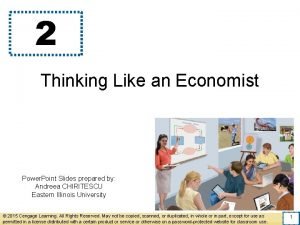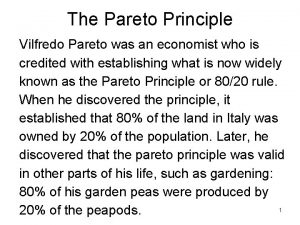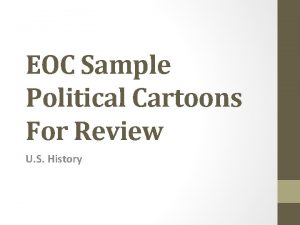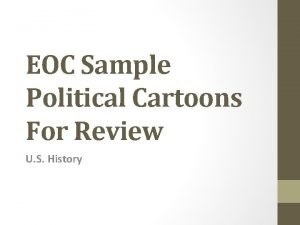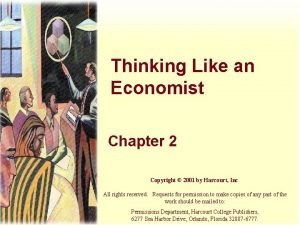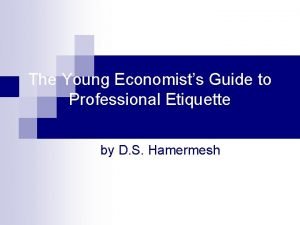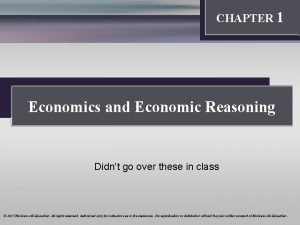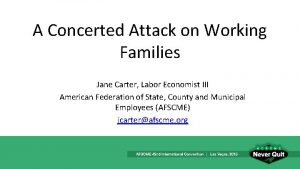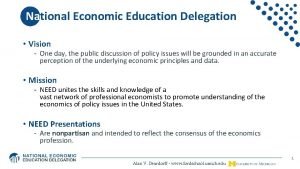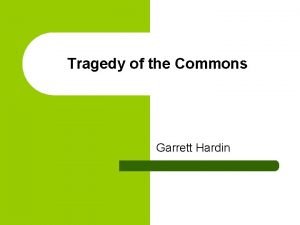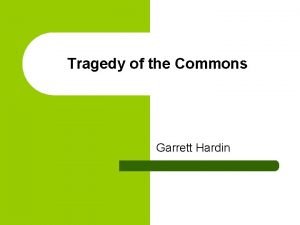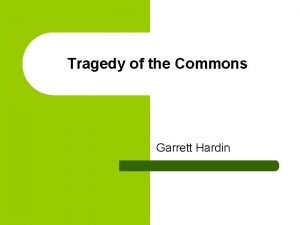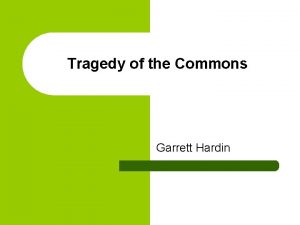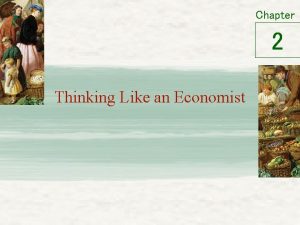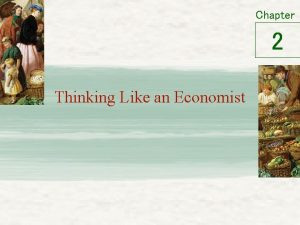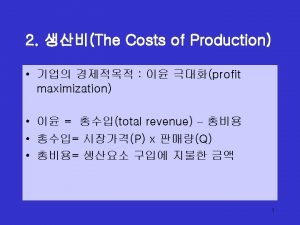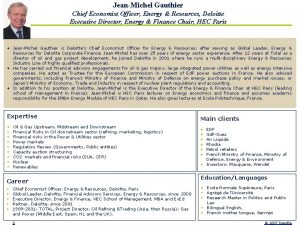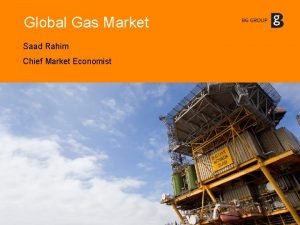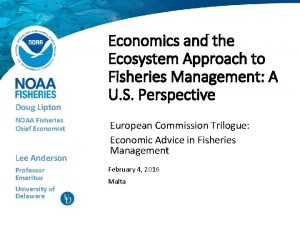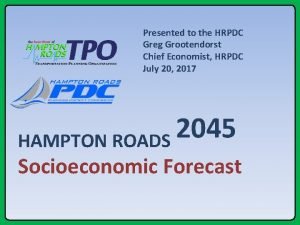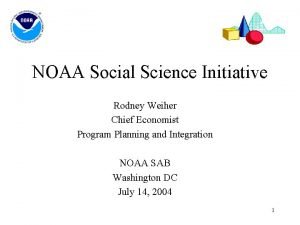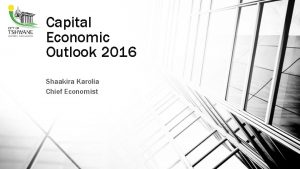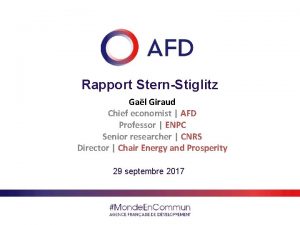Office of the Chief Economist Office of Energy



















- Slides: 19

Office of the Chief Economist Office of Energy Policy and New Uses Bioenergy and the USDA: Policy Perspectives Harry S. Baumes, Ph. D. Associate Director Office of Energy Policy and New Uses The Economics of Alternative Energy Sources and Globalization: The Road Ahead Embassy Suites Airport Orlando, Florida November 16, 2009

Office of the Chief Economist Office of Energy Policy and New Uses BACKGROUND • Energy Independence and Security Act of 2007 – RFS 2 – GHG Reductions • Food, Conservation and Energy Act of 2008 – Energy Title IX • Positions and Personalities

Office of the Chief Economist Office of Energy Policy and New Uses President Obama’s Commitment to Renewable Energy “To put people back to work today, and reduce our dependence on foreign oil tomorrow, we will double renewable energy production. ”

Office of the Chief Economist Office of Energy Policy and New Uses President Commitment to Renewable Energy “From China to India, from Japan to Germany, nations everywhere are racing to develop new ways to produce and use energy. The nation that wins this competition is the nation that will lead the global economy. I am convinced of that. And I want America to be Remarks made at MIT, October 23, 2009

Office of the Chief Economist Office of Energy Policy and New Uses “USDA is working to expand energy opportunities by producing alternative forms of energy and fuel, and to ensure that we are doing the research necessary to allow agriculture to transition away from its rather significant dependence on fossil fuels. ” Tom Vilsack Agriculture Secretary

Office of the Chief Economist Office of Energy Policy and New Uses EISA – EPACT Renewable Fuels Standard Other Biofuels Biobased Diesel Cellulosic Biofuels Conventional Corn Starch RFS 1 Years

Office of the Chief Economist Office of Energy Policy and New Uses U. S. Biodiesel Production, 1999 -2009 800 700 600 Million gallons 500 400 300 200 100 0 1999 2000 2001 2002 2003 2004 2005 2006 2007 2008 2009 e

Office of the Chief Economist Office of Energy Policy and New Uses U. S. Ethanol Production, 1980 -2009 12000 10000 8000 Million gallons 6000 4000 2000 0 198 2 198 4 198 6 198 8 199 0 199 2 199 4 199 6 199 8 200 0 200 2 200 4 200 6 200 8

Office of the Chief Economist Office of Energy Policy and New Uses Biofuels Interagency Working Group On May 5, 2009, President Obama signed the directive establishing a new working group to be chaired by the Secretaries of Energy and Agriculture and the Administrator of the EPA. The group will work with the National Biomass Research and Development Board on: – Creating a biofuel market development program to boost next-generation biofuels, increase use of flex-fuel vehicles, and assist retail market development – Coordinating infrastructure policies

Office of the Chief Economist Office of Energy Policy and New Uses Food, Conservation, and Energy Act of 2008 Title IX – Energy • • Federal Procurement of Biobased Products (9002) Biorefineries Assistance (9003) Repowering Assistance (9004) Bioenergy Program for Advanced Biofuels (9005) Rural Energy for America Program (9007) Biomass Research and Development (9008) Biomass Crop Assistance Program (9011) Forest Biomass for Energy (9012)

Farm Bill Title IX Office of the Chief Economist Section 9006 Funding Activity FY 2003 - 2008 Office of Energy Policy and New Uses Renewable Energy/Energy Efficiency Loans, Grants & Combos Amount $65, 188, 772 48, 008, 511 4, 683, 405 1, 969, 517 2, 620, 736 $122, 470, 941 Technology Biomass Wind Solar Geothermal Hybrid Subtotal No. 271 245 108 52 18 694 Energy Efficiency 1, 329 $34, 456, 722 $76, 743, 867 Subtotal 2, 023 $156, 927, 663 $1, 082, 245, 559 153 2, 176 $91, 529, 855 $248, 457, 518 $181, 321, 296 $1, 263, 566, 855 Guaranteed Loans Grand Total Leveraged $321, 322, 470 582, 427, 329 11, 207, 057 4, 576, 639 85, 968, 197 $1, 005, 501, 692

Office of the Chief Economist Office of Energy Policy and New Uses Looking Ahead • USDA working with the EPA – final rule for implementation of the RFS 2 • EPA Ruling on Growth Energy Waiver Request – raise fuel blend to 15% • House and Senate Energy Bills • Commitment by USDA to Expand Biofuels (Biomass) Production • USDA Strategic Plan • IWG - Biofuels

Office of the Chief Economist Office of Energy Policy and New Uses Biofuels • 1 st generation, corn-ethanol, sugar-ethanol, biodiesel, used vegetable oil, animal fats • 2 nd generation, cellulosic biofuels • 3 rd & 4 th generation, biofuel from organic wastes (solid waste, biosolids, animal wastes, green wastes, food production and pulp and paper wastes, plastics, auto shredding residues, tires) and biofuel from plants that can sequester high levels of CO 2 (algae, eucalyptus)

Office of the Chief Economist Office of Energy Policy and New Uses Expanding Biofuel Feedstock • Increasing export demand for food and high crop returns compete for land limit the conversion to dedicated energy crops • Expansion of land comes from - cropland, cropland idled by farmers and government programs, cropland pasture, and summer fallow – limited resource • International response to higher commodity prices can change the equation • Cropland expansion at the global level is possible in several countries (Angola, Rep. of Congo, Sudan, Brazil, Argentina, and others) • Conversion of land (rain forest, savanna and pasture) to crops in the above countries can increase GHG emissions

Office of the Chief Economist Office of Energy Policy and New Uses Environmental Issues • • • Land-use (direct and indirect) Nutrient and other contaminant runoff Water quality and availability Soil loss due to water and wind erosion Greenhouse gas emissions ( CO 2 and non CO 2)

Office of the Chief Economist Office of Energy Policy and New Uses BIOFRENZY

Office of the Chief Economist Office of Energy Policy and New Uses Friday, July 4, 2008 by The Guardian / UK

Office of the Chief Economist Office of Energy Policy and New Uses BIOFRENZY At USDA with Commitment and Direction

Office of the Chief Economist Office of Energy Policy and New Uses THANK YOU! Contact Information: Harry S. Baumes hbaumes@oce. usda. gov 202 -401 -0497
 Lesson 3 commander in chief and chief diplomat
Lesson 3 commander in chief and chief diplomat Thinking like an economist summary
Thinking like an economist summary Thinking like an economist ppt
Thinking like an economist ppt Lower outer fence
Lower outer fence A wise economist asks a question analysis
A wise economist asks a question analysis Watergate
Watergate What does the man on the park bench represent
What does the man on the park bench represent Thinking like an economist chapter 2
Thinking like an economist chapter 2 The young economist's guide to professional etiquette
The young economist's guide to professional etiquette Thinking like an economist chapter 1
Thinking like an economist chapter 1 Chapter 2 thinking like an economist
Chapter 2 thinking like an economist Chapter 2 thinking like an economist summary
Chapter 2 thinking like an economist summary Jane carter labor economist
Jane carter labor economist Economist.com
Economist.com Economist.com
Economist.com Economist china trade
Economist china trade Tragedy ofthe commons examples
Tragedy ofthe commons examples Travedy of the commons
Travedy of the commons The tragedy of the commons garrett hardin
The tragedy of the commons garrett hardin Hardin economist
Hardin economist


